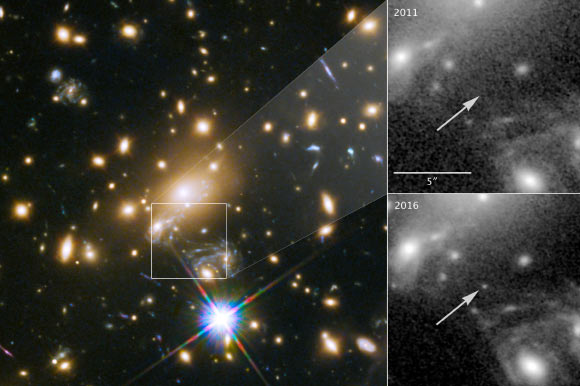A blue supergiant star nicknamed Icarus is so far away that its light has taken 9 billion years to reach our planet. It appears to us as it did when the Universe was about 30% of its current age.

This image composite shows the discovery of the Icarus star using the NASA/ESA Hubble Space Telescope. The image to the left shows a part of the deep-field observation of the galaxy cluster MACS J1149.5+2223 from the Frontier Fields program gathered in 2014. The square indicates the position where the star appeared in May 2016 — its image magnified by gravitational microlensing. This part of the image also shows the four images of the Refsdal supernova, arranged in an Einstein cross. The upper right image pinpoints the position of the star, observed in 2011. The lower right image shows where the star was undergoing the microlensing event in late May 2016. Image credit: NASA / ESA / P. Kelly, University of California, Berkeley.
While astronomers routinely study galaxies much farther away, they’re visible only because they glow with the brightness of billions of stars.
And a supernova, often brighter than the galaxy in which it sits, also can be visible across the entire Universe.
Beyond a distance of about 100 million light years, however, the stars in these galaxies are impossible to make out individually.
But a phenomenon called gravitational lensing can magnify the distant Universe and make dim, far away objects visible.
Typically, lensing magnifies galaxies by up to 50 times, but in this case, the Icarus star was magnified more than 2,000 times.
The star, whose official name is MACS J1149+2223 Lensed Star 1, was discovered in images taken between April 2016 and April 2017 by the NASA/ESA Hubble Space Telescope.
“The Icarus star became bright enough to be visible for Hubble thanks to a process called gravitational lensing,” said Dr. Jose Diego, an astronomer with the Instituto de Física de Cantabria, Spain.
“The light from the star was magnified not only by the huge total mass of the galaxy cluster MACS J1149+2223, but also by another compact object of about three times the mass of the Sun within the galaxy cluster itself; an effect known as gravitational microlensing.”
“This is the first time we’re seeing a magnified, individual star. You can see individual galaxies out there, but this star is at least 100 times farther away than the next individual star we can study, except for supernova explosions,” added Dr. Patrick Kelly, a researcher at the University of Minnesota, Twin Cities.
“For the first time ever we’re seeing an individual normal star — not a supernova, not a gamma ray burst, but a single stable star — at a distance of 9 billion light years. Gravitational lenses are amazing cosmic telescopes,” said Professor Alexei Filippenko, from the University of California, Berkeley.
The observations with Hubble were actually performed in order to detect and follow the latest appearance of the gravitationally lensed supernova explosion nicknamed Refsdal, when an unexpected point source brightened in the same spiral galaxy that hosted the supernova.
“Like the Refsdal supernova explosion the light of this distant star got magnified, making it visible for Hubble,” Dr. Kelly said.
“This star is at least 100 times farther away than the next individual star we can study, except for supernova explosions.”
“The discovery allows us to gather new insights into the constituents of the galaxy cluster. We know that the microlensing was caused by either a star, a neutron star, or a stellar-mass black hole,” said Dr. Steven Rodney, from the University of South Carolina.
The Icarus star therefore allows astronomers to study neutron stars and black holes, which are otherwise invisible and they can estimate how many of these dark objects exist within the MACS J1149+2223 galaxy cluster.
As galaxy clusters are among the largest and most massive structures in the Universe, learning about their constituents also increases our knowledge about the composition of the Universe overall. This includes additional information about the mysterious dark matter.
“If dark matter is at least partially made up of comparatively low-mass black holes, as it was recently proposed, we should be able to see this in the light curve of this star,” Dr. Kelly said.
“Our observations do not favor the possibility that a high fraction of dark matter is made of these primordial black holes with about 30 times the mass of the Sun.”
After the discovery the astronomers used Hubble again to measure a spectrum of the Icarus star.
Based on their analysis, they think that the Icarus star is a B-type supergiant star.
These stars are extremely luminous and blue in color, with a surface temperature between 11,000 and 14,000 degrees Celsius; making them more than twice as hot as the Sun.
But this was not the end of the story. Observations made in October 2016 suddenly showed a second image of the star.
“We were actually surprised to not have seen this second image in earlier observations, as also the galaxy the star is located in can be seen twice,” Dr. Diego said.
“We assume that the light from the second image has been deflected by another moving massive object for a long time — basically hiding the image from us. And only when the massive object moved out of the line of sight the second image of the star became visible.”
“This second image and the blocking object add another piece of the puzzle to reveal the makeup of galaxy clusters.”
A paper reporting the discovery of the Icarus star is published in the journal Nature Astronomy.
_____
Patrick L. Kelly et al. 2018. Extreme magnification of an individual star at redshift 1.5 by a galaxy-cluster lens. Nature Astronomy 2: 334-342; doi: 10.1038/s41550-018-0430-3







